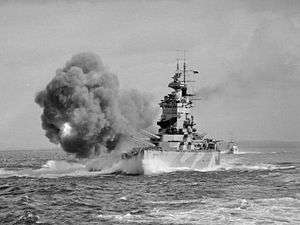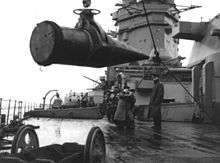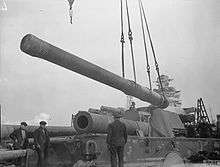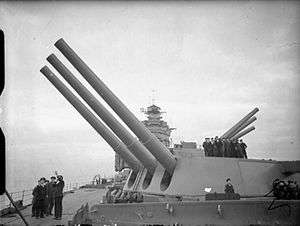BL 16 inch Mk I naval gun
| Ordnance BL 16 inch Mark I | |
|---|---|
|
Guns of HMS Rodney at maximum elevation, 1940 | |
| Type | naval gun |
| Place of origin | UK |
| Service history | |
| In service | 1927-1948 |
| Used by | UK |
| Production history | |
| Designed | 1922 |
| Specifications | |
| Weight | 108 tons (109.7 tonnes) |
| Length | 61 ft 10 in (18.85 m) |
| Barrel length | 60 ft (18.3 m) |
|
| |
| Shell | separate charge, AP shell |
| Shell weight | 2,048 pounds (929 kg) |
| Calibre | 16 inch (406 mm) |
| Breech | Welin |
| Elevation | 40° in mounting Mark I |
| Rate of fire | 1.5 rounds per minute as fitted |
| Muzzle velocity | 2,586 feet/second (788 m/s) |
| Effective firing range | 35,000 yards (32,000 m) at 32° elevation |
| Maximum firing range | 39,780 yards (36,375 m) |
The BL 16 inch Mark I was a British naval gun introduced in the 1920s and used on the two Nelson-class battleships. A breech loading gun, the barrel was 45 calibres long ("/45" in shorthand) meaning 45 times the bore (16 in) - 60 ft (18 m) long.
Description
These wire-wound built-up guns had originally been planned for the cancelled G3-class battlecruiser design upon which the Nelson-class battleship drew.
Sir W. G. Armstrong Whitworth & Company at Elswick, Vickers at Barrow-in-Furness, William Beardmore & Company at Dalmuir and the Royal Gun Factory at Woolwich made a total of 29 guns of which 18 would be required for both ships at any time.
.jpg)

These guns broke with the example offered by the earlier 15 inch Mk I gun, which fired a heavy shell at a rather low muzzle velocity, and instead fired a rather light shell at a high muzzle velocity; this was not a success, as at the initial muzzle velocity the gun wore down rapidly and the accuracy was unsatisfactory, so much that it was lowered. Furthermore, a heavier shell was proposed but not adopted because of stringent budget policies of the 1930s; therefore, this naval gun wasn't seen as particularly successful.[1]
An improved weapon, the BL 16 inch Mark II was designed for the Lion-class battleship which was a successor to the King George V class taking advantage of the larger weapon allowed under the London Naval Treaty from March 1938. This "new design" of 16-inch gun fired a shell that weighed 2,375 lb (1,077 kg). Construction of first two Lion battleships - each of which was to have nine 16-inch guns - was halted at the start of the Second World War; only a few months after they were laid down.[2] Work on the armament continued for a while but that was also stopped after only four guns and no turrets were produced.
See also


Weapons of comparable role, performance and era
- 41 cm/45 3rd Year Type naval gun: Japanese equivalent
- 16"/45 caliber Mk 1, 5 & 8 gun: American equivalent
Notes
References
- Tony DiGiulian, British 16"/45 (40.6 cm) Mark I
- Terry Duncan, British 16" Mark I Gun and Mounting
External links
| Wikimedia Commons has media related to BL 16 inch Mk I naval gun. |
